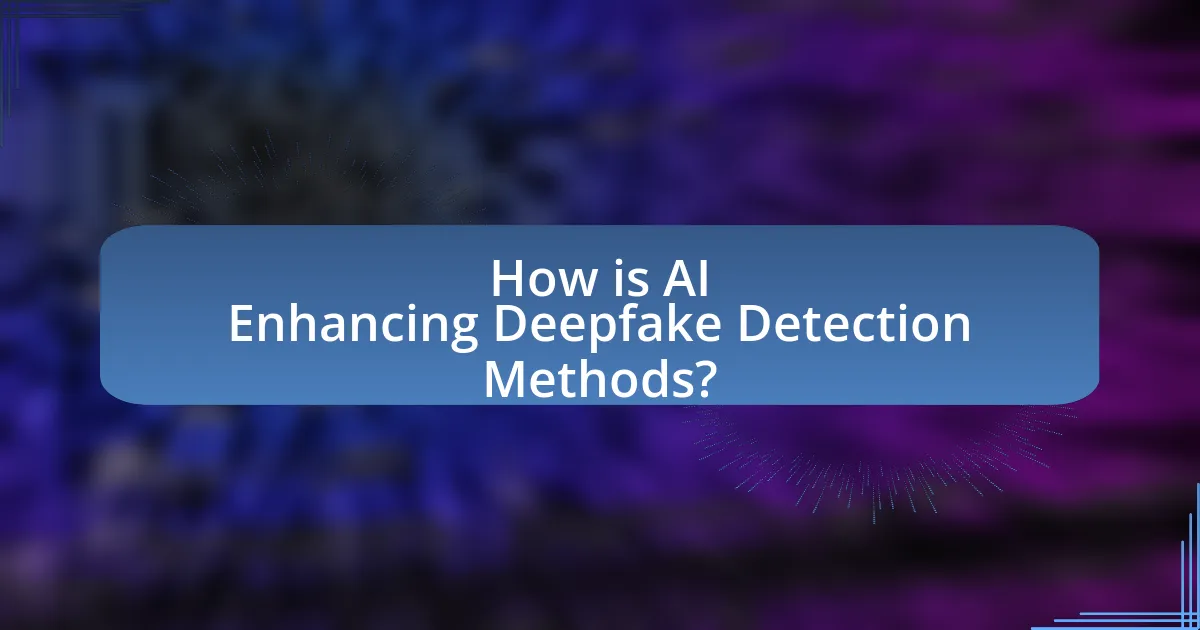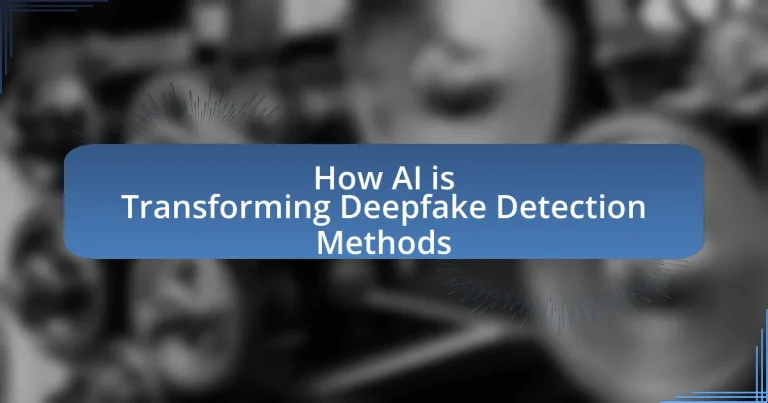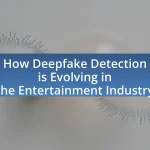Deepfakes are synthetic media generated through artificial intelligence, particularly deep learning, raising significant concerns regarding misinformation, identity theft, and erosion of trust in media. This article explores how deepfakes are created using technologies like Generative Adversarial Networks (GANs) and highlights their applications in entertainment, education, and advertising. It also addresses the risks associated with deepfakes, including their impact on personal privacy and the spread of false narratives. Furthermore, the article examines advancements in AI that enhance deepfake detection methods, the challenges faced in identifying manipulated content, and future trends in detection technologies, emphasizing the importance of effective strategies and tools for combating deepfake threats.

What are Deepfakes and Why are They a Concern?
Deepfakes are synthetic media created using artificial intelligence techniques, particularly deep learning, to manipulate or generate realistic images, audio, or video of individuals. They are a concern because they can be used to spread misinformation, damage reputations, and undermine trust in media, as evidenced by incidents where deepfakes have been employed in political campaigns and social media to create false narratives. The potential for misuse is significant, with studies indicating that 96% of deepfake videos are pornographic in nature, highlighting the ethical and legal challenges they pose.
How do Deepfakes work?
Deepfakes work by using artificial intelligence, specifically deep learning techniques, to create realistic-looking fake media. The process typically involves training a neural network on a large dataset of images and videos of a target individual, allowing the model to learn their facial features, expressions, and movements. Once trained, the model can generate new content by swapping faces in videos or images, making it appear as though the target individual is performing actions or speaking words they never actually did. This technology relies on Generative Adversarial Networks (GANs), where two neural networks compete against each other to improve the quality of the generated media, resulting in increasingly convincing deepfakes.
What technologies are used to create Deepfakes?
Deepfakes are primarily created using artificial intelligence technologies, specifically Generative Adversarial Networks (GANs). GANs consist of two neural networks, a generator and a discriminator, that work against each other to produce realistic synthetic media. The generator creates fake images or videos, while the discriminator evaluates them against real data, improving the generator’s output over time. This technology has been validated through various studies, including one published in 2014 by Ian Goodfellow and colleagues, which introduced GANs and demonstrated their effectiveness in generating high-quality images. Other techniques used in deepfake creation include autoencoders and convolutional neural networks (CNNs), which further enhance the realism of the generated content.
What are the common applications of Deepfakes?
Common applications of deepfakes include entertainment, education, and advertising. In entertainment, deepfakes are used to create realistic visual effects in movies and television, allowing for the seamless integration of actors’ performances. In education, they can enhance learning experiences by simulating historical figures or events, providing immersive educational content. In advertising, brands utilize deepfake technology to create personalized marketing campaigns that resonate with consumers. These applications demonstrate the versatility of deepfakes across various industries, leveraging advanced AI techniques to produce compelling and engaging content.
What are the risks associated with Deepfakes?
Deepfakes pose significant risks, including misinformation, identity theft, and erosion of trust in media. Misinformation can lead to the spread of false narratives, as deepfakes can convincingly alter reality, influencing public opinion and political outcomes. Identity theft occurs when individuals’ likenesses are manipulated without consent, potentially damaging reputations and privacy. Furthermore, the erosion of trust in media is evident as audiences may become skeptical of authentic content, making it challenging to discern truth from fabrication. A study by the University of California, Berkeley, highlights that 96% of surveyed individuals expressed concern about the potential misuse of deepfake technology, underscoring the widespread recognition of these risks.
How can Deepfakes impact personal privacy?
Deepfakes can significantly impact personal privacy by enabling the creation of realistic but fabricated videos or audio recordings that can misrepresent individuals. This technology allows malicious actors to manipulate images and sounds, leading to potential identity theft, defamation, and unauthorized use of a person’s likeness. For instance, a study by the University of California, Berkeley, found that deepfake technology can be used to create convincing fake videos that can damage reputations and invade personal privacy, as individuals may find their likeness used in inappropriate or harmful contexts without consent.
What are the implications of Deepfakes in misinformation?
Deepfakes significantly exacerbate misinformation by creating highly realistic but fabricated audio and visual content that can mislead audiences. This technology enables the manipulation of public perception, as seen in instances where deepfakes have been used to impersonate political figures or spread false narratives, undermining trust in media and institutions. Research indicates that 96% of deepfake videos are pornographic, but the remaining 4% often involve political or social manipulation, highlighting the potential for harm in critical contexts. The rapid advancement of deepfake technology poses challenges for verification and authenticity, making it increasingly difficult for individuals to discern truth from deception.

How is AI Enhancing Deepfake Detection Methods?
AI is enhancing deepfake detection methods by utilizing advanced machine learning algorithms that can analyze and identify inconsistencies in video and audio content. These algorithms are trained on large datasets of both genuine and manipulated media, enabling them to recognize subtle artifacts and anomalies that are often present in deepfakes, such as unnatural facial movements or mismatched audio-visual cues. For instance, a study published in 2020 by the University of California, Berkeley, demonstrated that AI models could achieve over 90% accuracy in detecting deepfakes by focusing on these specific discrepancies. This capability allows for more reliable identification of manipulated content, thereby improving the overall effectiveness of deepfake detection systems.
What role does machine learning play in detecting Deepfakes?
Machine learning plays a crucial role in detecting Deepfakes by analyzing patterns and anomalies in digital content. Algorithms trained on vast datasets can identify inconsistencies in facial movements, audio synchronization, and other features that are often manipulated in Deepfake videos. For instance, a study published in 2020 by the University of California, Berkeley, demonstrated that machine learning models could achieve over 90% accuracy in distinguishing between real and Deepfake videos by focusing on subtle artifacts that human viewers might miss. This capability allows for the development of automated detection tools that can quickly assess the authenticity of media, thereby enhancing the reliability of information in an era increasingly plagued by misinformation.
What algorithms are commonly used in AI-based detection?
Common algorithms used in AI-based detection include Convolutional Neural Networks (CNNs), Recurrent Neural Networks (RNNs), and Generative Adversarial Networks (GANs). CNNs are particularly effective for image and video analysis, enabling the identification of patterns and anomalies in visual data. RNNs excel in processing sequential data, making them suitable for analyzing temporal patterns in videos. GANs are utilized to generate synthetic data, which can be used to train detection models by simulating deepfake scenarios. These algorithms have been validated through various studies, demonstrating their effectiveness in distinguishing between real and manipulated content in deepfake detection.
How effective are these algorithms in identifying Deepfakes?
Algorithms for identifying Deepfakes are highly effective, achieving accuracy rates exceeding 90% in many cases. Research indicates that advanced machine learning techniques, such as convolutional neural networks (CNNs) and recurrent neural networks (RNNs), significantly enhance detection capabilities by analyzing subtle inconsistencies in facial movements and audio-visual synchronization. For instance, a study published in 2020 by Korshunov and Marcel demonstrated that their algorithm could detect Deepfakes with an accuracy of 94% using a dataset of manipulated videos. This high level of effectiveness underscores the growing reliance on AI-driven methods for combating the proliferation of Deepfake technology.
What are the challenges faced in Deepfake detection?
Deepfake detection faces several significant challenges, primarily due to the rapid advancement of deepfake technology and the sophistication of the generated content. One major challenge is the continuous evolution of deepfake algorithms, which makes it difficult for detection systems to keep pace; for instance, generative adversarial networks (GANs) can produce increasingly realistic videos that evade traditional detection methods. Additionally, the lack of large, labeled datasets for training detection models hampers their effectiveness, as many existing datasets do not encompass the variety of deepfake techniques currently in use. Furthermore, the subtlety of certain manipulations, such as facial expressions and lip-syncing, complicates the identification process, leading to false negatives. Lastly, the potential for adversarial attacks on detection systems poses a risk, as malicious actors may deliberately create deepfakes designed to bypass detection algorithms.
How do evolving Deepfake technologies complicate detection efforts?
Evolving Deepfake technologies complicate detection efforts by continuously improving the realism and sophistication of manipulated media. As these technologies advance, they utilize more complex algorithms and deep learning techniques, making it increasingly difficult for traditional detection methods to identify alterations. For instance, recent advancements in generative adversarial networks (GANs) have enabled the creation of highly convincing fake videos that can evade existing detection systems, which often rely on identifying artifacts or inconsistencies in the media. This ongoing evolution necessitates the development of more advanced detection tools that can adapt to the changing landscape of Deepfake technology.
What limitations exist in current AI detection methods?
Current AI detection methods face several limitations, including high false positive rates, difficulty in detecting novel deepfake techniques, and reliance on large datasets for training. High false positive rates can lead to misidentification of genuine content as manipulated, undermining trust in detection systems. Additionally, as deepfake technology evolves, existing detection methods struggle to keep pace with new techniques, resulting in decreased effectiveness. Furthermore, many AI detection models require extensive labeled datasets for training, which can be challenging to obtain, particularly for emerging deepfake types. These limitations highlight the ongoing challenges in developing robust and reliable AI detection systems.

What are the Future Trends in AI and Deepfake Detection?
Future trends in AI and deepfake detection include the development of more sophisticated algorithms that leverage machine learning and neural networks to identify subtle inconsistencies in deepfake content. These advancements are driven by the increasing complexity of deepfake technology, which requires detection systems to evolve rapidly. For instance, researchers are focusing on using generative adversarial networks (GANs) to create training datasets that improve detection accuracy. Additionally, real-time detection capabilities are becoming a priority, enabling systems to analyze video streams instantly. The integration of blockchain technology for content verification is also emerging, providing a transparent method to trace the authenticity of media. These trends are supported by ongoing research, such as the study published in “IEEE Transactions on Information Forensics and Security,” which highlights the effectiveness of AI-based detection methods in combating deepfakes.
How is AI expected to evolve in the context of Deepfake detection?
AI is expected to evolve in the context of Deepfake detection by integrating advanced machine learning algorithms and real-time analysis capabilities. These advancements will enhance the accuracy and speed of identifying manipulated media, as evidenced by the development of deep learning models that can detect subtle inconsistencies in video and audio content. For instance, research from Stanford University demonstrated that AI models could achieve over 90% accuracy in distinguishing between real and deepfake videos by analyzing facial movements and audio patterns. This evolution will likely include the use of generative adversarial networks (GANs) to create more sophisticated detection tools, thereby staying ahead of increasingly realistic deepfake technologies.
What advancements are on the horizon for detection technologies?
Advancements on the horizon for detection technologies include the development of AI-driven algorithms that enhance the accuracy and speed of identifying deepfakes. These algorithms leverage machine learning techniques, such as convolutional neural networks, to analyze visual and audio inconsistencies in media. Research indicates that these AI models can achieve over 90% accuracy in detecting manipulated content, significantly improving upon traditional methods. Additionally, the integration of blockchain technology for verifying the authenticity of media sources is being explored, providing a robust framework for ensuring content integrity.
How might regulations influence the development of detection methods?
Regulations can significantly influence the development of detection methods by establishing standards and requirements that technologies must meet. For instance, regulatory frameworks may mandate the implementation of specific algorithms or technologies to ensure the accuracy and reliability of detection methods. This can lead to increased investment in research and development, as companies strive to comply with these regulations. Additionally, regulations can drive innovation by encouraging collaboration between tech companies and regulatory bodies, fostering the creation of more sophisticated detection tools. Historical examples include the introduction of GDPR in Europe, which has prompted advancements in data privacy technologies, influencing how detection methods are designed to protect user information while identifying deepfakes.
What best practices can be adopted for effective Deepfake detection?
Effective Deepfake detection can be achieved by implementing a combination of advanced machine learning algorithms, continuous model training, and multi-modal analysis. Advanced machine learning algorithms, such as convolutional neural networks (CNNs), have been shown to identify subtle inconsistencies in video and audio that may indicate manipulation. Continuous model training is essential, as the technology behind Deepfakes evolves rapidly, necessitating regular updates to detection models to maintain accuracy. Multi-modal analysis, which involves examining both visual and auditory elements of content, enhances detection capabilities by providing a more comprehensive assessment of authenticity. Research indicates that these practices significantly improve detection rates, with studies showing that models utilizing these techniques can achieve over 90% accuracy in identifying Deepfakes.
How can individuals and organizations stay informed about Deepfake threats?
Individuals and organizations can stay informed about Deepfake threats by regularly following reputable sources of information, such as cybersecurity blogs, academic journals, and government advisories. For instance, organizations like the Cybersecurity and Infrastructure Security Agency (CISA) provide updates and resources on emerging threats, including Deepfakes. Additionally, subscribing to newsletters from technology and security firms that specialize in AI and digital forensics can offer timely insights. Engaging with online communities and forums focused on cybersecurity can also facilitate knowledge sharing and awareness of the latest Deepfake developments.
What tools and resources are available for detecting Deepfakes?
Several tools and resources are available for detecting Deepfakes, including Deepware Scanner, Sensity AI, and Microsoft Video Authenticator. Deepware Scanner utilizes machine learning algorithms to analyze videos for signs of manipulation, while Sensity AI offers a comprehensive platform that identifies and tracks Deepfake content across various media. Microsoft Video Authenticator assesses images and videos to provide a confidence score regarding their authenticity. These tools leverage advanced AI techniques to enhance detection accuracy, as evidenced by their deployment in various media and security applications.


